Repair Culture
Re-Invented Objects
That’s what Cuban artist and researcher Ernesto Oroza calls these “inventions of neccessity.” For eight years he has collected everyday objects crafted from discards, and re-purposed technology found in Cuba. Where purchased goods are in short supply, people fix their own. He’s shown these re-invented objects in several exhibitions. For instance, here is a razor made with the blade and a pencil.

Or a fan blade repaired with a piece of vinyl record.

There are others. Check out this set of chairs constructed from broken plastic chairs given a new rebar skeleton.
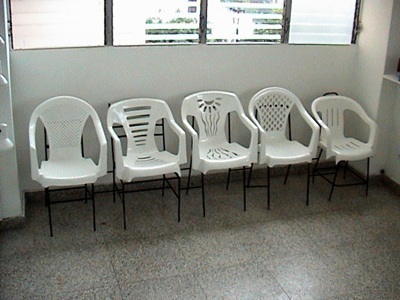
Many of Oroza’s objects were photographed and collected into a booklet called No Waste, which was publshed by Pentagram and is now out of print (available in a handful of libraries).
Homebrew FM Radio Station in India
In February, 2006 the BBC.com had a good article on an DIY low-powered FM radio station operated out of a electronics repair shop. I’d be surprised if this was the only one in India (or Asia) like this. The owner-builder claims not to know that broadcasting required a license. The station, he says, just sort of grew from his junk and his interests.
“On a balmy morning in India’s northern state of Bihar, young Raghav Mahato gets ready to fire up his home-grown FM radio station. It may well be the only village FM radio station on the Asian sub-continent. It is certainly illegal. The transmission equipment, costing just over $1, may be the cheapest in the world.
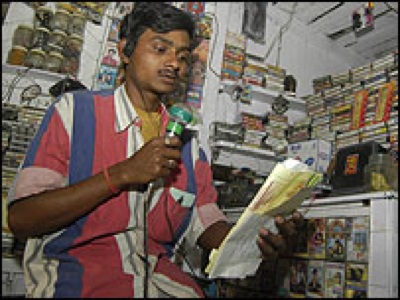
The transmission kit is fitted on to an antenna attached to a bamboo pole on a neighbouring three-storey hospital. A long wire connects the contraption to a creaky, old homemade stereo cassette player in Raghav’s radio shack. Three other rusty, locally made battery-powered tape recorders are connected to it with colourful wires and a cordless microphone. The radio station is a repair shop and studio rolled into on. The shack has some 200 tapes of local Bhojpuri, Bollywood and devotional songs which Raghav plays for his listeners. Raghav’s station is truly a labour of love – he does not earn anything from it. His electronic repair shop work brings him some two thousand rupees ($45) a month.”
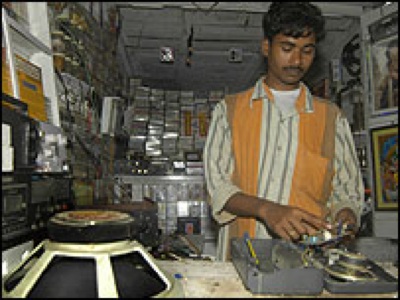
Raghav makes his living from repairing electronic goods.
The Bottomless Ink Cartridge
From the extensive archive of repair culture at Jan Chipcase’s blog Future Perfect comes these two glimpses of street vendors filling a need. The need is for cheap ink jet cartridges. Why not refill them while U wait?

Here an ink refiller works in Ho Chi Minh City, Vietnam.
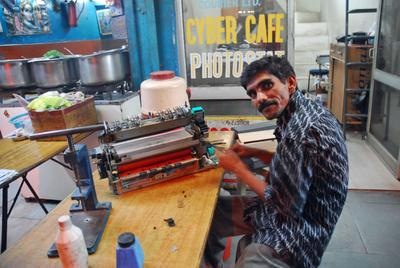
This shop operates in New Delhi, India.
Mismatched Makeshift Door Handle
It’s all in the details. Why do door handles need to be symmetrical? In fact there may be good reasons to have them different — perhaps to invite visitors to use one side before the other. But in this case it looks like it’s simply a sign that one can purchase a replacement part of one type but not the other. In other words one side is more repairable then the other. Much of street use is repair work. And sometimes repair work is improvement. A good question surfaces: with this repair is one side of the door now more usable than the other? If you came upon this unequal set, which side would you reach for? Thanks to Splintered*Light for posting this on Flickr.
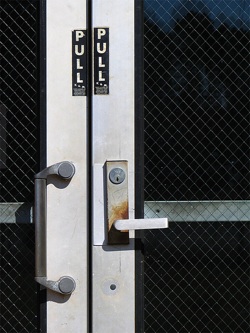
Slack In China’s Wiring
It always makes sense to leave a little slack when you are doing wiring. Once you cut a wire, it’s hard to “glue” back together again. So why do I find this massive scale slack in wiring on a downtown street in Shanghai so amusing? It’s entirely logical. No sooner do you add one hookup, you’re going to need to add another. In the developed countries, we hide our anticipation. In China they flaunt it. “Hey, we are growing so fast, there’s no need to tidy anything up!”
Never Say Die
There is something beautiful about how some old things are improved with repair. In Asia, broken large pots and fine china were usually mended by drilling holes near the edge of the broken pieces and then binding the shards together with flattened brass wire. Here are some ceramic pots in China that were mended this way. The small one I saw on the island near Shanghai, and the large one near a village in Zhuji (near Nimbo, also near Shanghai) used for washing clothes. They are very waterproof, and seem to work as good as new. But to my eye, the repair strands add a wonderful texture.


